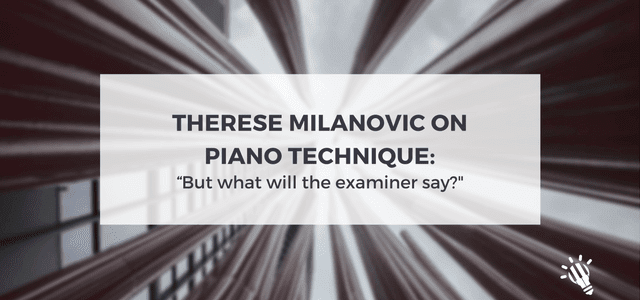I recently found this four-part series by Brisbane-based teacher and presenter Therese Milanovic, and just had to share it with you. (It’s going to be particularly relevant to all the Aussie teachers who use the AMEB exam syllabus.)
As a teacher of exam students, I’m often worried about what the examiner might think about my students’ technique, performance skills or their repertoire choices, particularly if I ‘bend the rules’ a bit and do things my own way.
In fact, I even posted a couple of years ago about questions that I’d asked Julie Haskell, one of the AMEB’s examiners in my article: Julie Haskell answers questions on AMEB exams. I was particularly keen to get her views on things that teachers always seem to wonder about: using photocopies, what has to be erased from the score before an exam (ps. it’s not what you think!), playing from memory, etc. Check out the article for all the answers.
Anyway, in this three-part series, Taubman-trained specialist Therese reminds us that there flexibility in approach to fingering of technical work is totally OK for AMEB exams, as long as the final product is appropriate.
***ps. Tune in on Sunday when I’m talking Piano Technique with a panel of guests on TTTV Episode 3: What does healthy piano technique mean to me?
Here’s how she starts the discussion:
One question I hear often in my studio is, “But what will the examiner say?”, usually after I’ve suggested an alternative fingering to get rid of a stretch, or (gasp) uncrossed the hands, or redistributed a chord. So I thought I’d write a series of posts addressing some of these concerns that so many piano teachers share.
A question I wish I heard as often is “But what will happen to my student if she uses the stretchy fingering indicated in the technical workbook?”, or “Is there a chance of injury if I insist that she connects everything physically? Or “What is the impact if I forbid her to omit a note to make a large chord more comfortable?” It seems all too often that the concern for the examiner’s opinion is usually held higher than concern for the health of the student.
If you’ve ever wondered if a student has to use his/her 4th finger in the LH when playing an arpeggio all on the white notes, or whether the fingering in general can be altered to suit each student, I highly recommend you check out her series as she answers all these question and more including excerpts and fingering notes.
Here’s the series so far:
Part 1: Alternative fingering for minor scales
Part 2: Alternate Fingering for AMEB Grade 3 Broken Chords
Make sure you check out Therese’s blog to get the next instalments when they are posted.
If you’ve had any problems with grading that examiners have given due to technical work, leave a comment below. Perhaps they’ve commented on fingering or made suggestions regarding technique?
